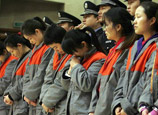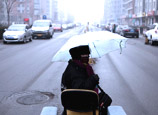
Illegal transport
Officials said they are clear about the cause of the tragedy. "It's certain that the extensive illegal production and transportation (of fireworks) caused this major accident," said Wang Dexue, vice-director of the State Administration of Work Safety, at the site of the accident.
Hongsheng Fireworks Manufacturing Co, based in Pucheng county in neighboring Shaanxi province, manufactured the explosives illegally, packaged them improperly and signed a transport contract with a trucking company that did not have a license to handle hazardous materials, according to sources from the Pucheng County Information Office.
The local authorities have now shut down the factory and four company officials have been detained.
Wang Baixing, an explosives expert who joined the investigation into the blast, said the fireworks the truck was carrying were of the larger variety and had huge explosive potential. The truck had a maximum load of 5 metric tons, but was actually carrying more than 9 tons, and its explosive power was equivalent to 1 ton of TNT.
Accidents involving fireworks happen almost every year in China. The Spring Festival holiday is generally considered a high-incident period.
On March 28 last year, a truck full of fireworks collided with a cement tanker on a highway in Anhui province. The accident triggered an explosion that killed four people and injured more than a dozen.
Trucks loaded with fireworks can become "mobile bombs", according to experts.
The Safety Regulations for Fireworks, released by the State Council, China's cabinet, specifies that fireworks must be transported in vehicles specifically designed to carry hazardous materials, and that drivers must have many years experience in the field. They are also obliged to undergo annual checks and training supervised by the transport department. Moreover, companies wishing to transport fireworks must apply for a special permit.
However, the reality is far removed from the regulations.
China is the world's largest producer of fireworks and also one of the world's biggest consumers. Most of the leading manufacturers are situated at the border of Hunan and Jiangxi provinces. The annual output of the cities of Liuyang and Liling in Hunan, and Shangli county in Jiangxi, accounts for more than half of the global total.
Every year more than 20,000 fireworks made in the region are transported to areas across China.
The huge demand for transport for fireworks has stimulated the development of the local logistics industry, but seasonal demand has led to imbalances. During the peak sales season - from September to January - there is a lack of available transport.
Data from Liuyang Transport Bureau show that in the peak sales season in 2011, at least 1,400 vehicles were needed to meet the demand for transport, but the city's 10 businesses licensed to carry hazardous material, plus those in the surrounding areas, had just 760 vehicles legally allowed to carry dangerous materials. That resulted in a huge shortfall. This year the shortage is estimated to be around 600.
The high cost of specially designed vehicles has also led to lower safety levels in transportation. The cost of using one of the trucks to carry fireworks from Hunan province to the northeast of the country can be as much as 5,000 to 6,000 yuan ($802 - $963) more than normal vehicles. To lower costs, manufacturers will often opt for illegal channels of transportation.
China Central Television reported on Saturday that more than 60 percent of trucks used to carry fireworks on the Chinese mainland don't have a proper license or permit to transport hazardous materials. They lack protective containers and few of the drivers are aware that some fireworks contain chemicals that can combust even after contact with water.
"In addition, the manufacture of fireworks is a high-risk industry; many local governments would rather forego the profits the industry brings than introduce the factories to their region. Take Henan province for instance, although it's a large consumer market for fireworks, more than 95 percent of them are brought in from Hunan and Jiangxi provinces," said Liu Wenjun, the manager of a wholesale fireworks business in Henan.
"The contradiction of consumer demand and over-concentrated production inevitably leads to an increase in demand for long-distance transportation," he said.
According to Xinhua News Agency, every year at the approach of Spring Festival, many truckers gather at the border of Hunan and Jiangxi in search of trade. The local authorities want the business and therefore often choose to turn a blind eye to the problem.
Experts have long called for stricter laws and tougher punishments - they want to see technological innovation and updated logistics to lower the risks. Despite those calls, the problem remains.
"To effectively prevent the transportation of illegal fireworks will require the combined efforts of both logistics companies and the fireworks manufacturers. The only way to lower the risk is to establish joint investment and joint operation of the two parties," said Hu Wenyong, vice-director of Liuyang Transportation Management Department, quoted by Legal Weekly in December 2012.
At an emergency meeting held by the Ministry of Public Security in the wake of the blast, Vice-Minister Huang Ming ordered to make concrete arrangements to supervise the transportation of fireworks, firecrackers and other dangerous materials during the upcoming holiday.

















 High-profile divorce saga ends
High-profile divorce saga ends


![]()
